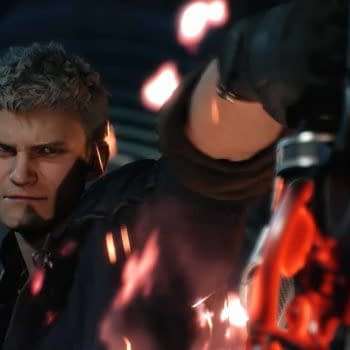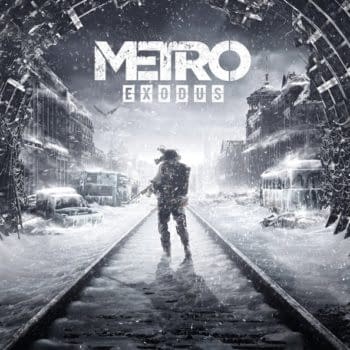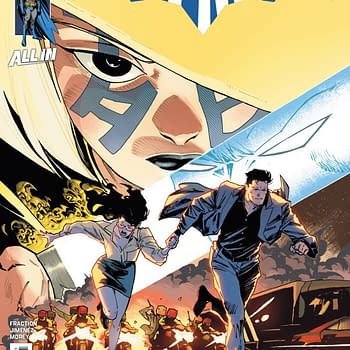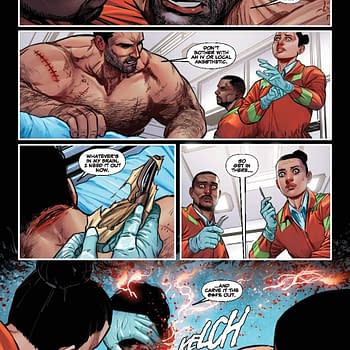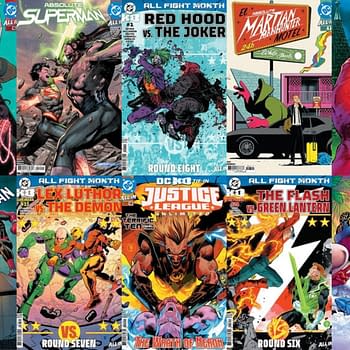Posted in: Comics | Tagged: cyrus perkins and the haunted taxi cab, fear and loathing in las vegas, house of m, where monsters dwell
Thor's Comic Review Column: Fear and Loathing in Las Vegas, Cyrus Perkins and the Haunted Taxi Cab #1, Secret Wars: Where Monsters Dwell #5 And Secret Wars: House of M #4
THIS WEEK'S REVIEWS:
Fear and Loathing in Las Vegas
Cyrus Perkins and the Haunted Taxi Cab #1
Secret Wars: Where Monsters Dwell #5
Secret Wars: House of M #4
Fear and Loathing in Las Vegas (IDW/Top Shelf Comix)
By Adam X. Smith
In case it wasn't painfully obvious before, Hunter S. Thompson's Fear and Loathing in Las Vegas: A Savage Journey to the Heart of the American Dream is easily my single favourite book – it's a brilliant piece of nonfiction masquerading as a drug-fuelled Divine Comedy, it inspired in a younger more idealistic version of this writer a fascination with journalism (and various substances), and it's one of the few cases where I loved the film adaptation just as much as the original. It is my Catcher in the Rye, my Great Gatsby, my The Fault in Our Stars. Well, TFIOS technically was my TFIOS, but it was definitely my Paper Towns, whatever that means.
So when word came down that Troy Little was going to adapt Raoul Duke and Doctor Gonzo's spaced-out odyssey into a graphic novel with the co-operation of the late Thompson's estate, I felt an obligation to cover the success or failure of it as an adaptation, not just for the column or my own curiosity, but as some sort of statement on the adaptation process. So many classic novels, films and TV shows are adapted into comics to varying degrees of quality and success, so having a personal stake in this book not being a steaming pile of bat guano seemed like as good a reason as any to make certain.
Having already seen a handful of preview pages and the cover, I was already pretty confident that the art style would work for me and indeed it did, combining as it does the distinctive visual landscapes of Ralph Steadman's original pen and ink cartoons that accompanied the book and the Rolling Stone article it was based on, likenesses and details from existing research materials, Terry Gilliam's queasy framing and art direction and Little's own distinctive style of drawing. But would it get the text right? Fear and Loathing is many things, but whilst it is a slim read, it is by no means lacking in sheer volume of words. Parsing that down to about 180 pages of art was always going to be tricky.
Mercifully, Little is able to do so with relatively little of consequence lost in the translation, only cutting where it's absolutely necessary (the hapless photographer Lacerda is notably absent, not that that's a dealbreaker) and even making time for scenes and details that would be (and have been) cut for timing in a film adaptation. It even simulates the "transcript only" section "Breakdown on Paradise Boulevard" with only a handful of out of context images to illustrate it, shows the bizarre spectacle of them crashing a Debbie Reynolds concert (complete with silver afro), and presents terrifying and bizarre hallucinations beyond even what Gilliam was able to achieve.
So as it stands, yes, it's a good adaptation – perhaps even a great one. And if I had to put my finger on why, I'd say it's because Little understands that the key to making this story work as a comic is by using the comic medium itself to tell the story – I know, what a concept! The book is heavy on dialogue and narration, but it knows when to use visual shorthand, and the position, orientation and even the font of the dialogue and narration balloons are clear and easily understood to represent the characters' varying emotions and state of consciousness; and whilst the designs of Duke and Gonzo are incredibly cartoonish renderings of their real-life counterparts, there's no way that they could be accidentally mistaken for Johnny Depp or Benicio Del Toro; this even carries over to the supporting characters, with Gonzo's strung-out plaything Lucy who has, as described in the book, "the face and form of a Pit Bull" looking practically subhuman.
Whilst hewing so close to the original book inevitably leads to less of the franctic, in-the-moment weirdness of the Gilliam film, it nonetheless presents a strong, accurate take on the material, whilst revivifying it for those too young to remember when Las Vegas hadn't been somewhat sanitised by gentrification and corporate interests – probably the only thing organised crime ever got right was showing people a good time in the middle of desert. Reading it, I was reminded of the book's final line:-
"… my heart was filed with joy. I felt like a monster reincarnation of Horatio Alger… A Man on the Move, and just sick enough to be totally confident."
Adam X. Smith bids you all Happy Halloween, Feliz Día de los Muertos, and God's mercy on you swine.
Cyrus Perkins and the Haunted Taxi Cab #1 (Action Lab, $3.99)
Sometimes it can be really difficult to review a new comic without giving the entire story away. The first issue of Cyrus Perkins is presenting that dilemma as I write this. There aren't any big surprises that I could spoil. In fact, the problem with reviewing this issue is quite the opposite. By knowing the title of this series, it's no exaggeration to say that just about everyone will know how this issue ends by the time they've read the first two pages.
Dave Dwonch is the writer of this story. If you've ever heard of him, it's probably because you've read some other Action Lab comics. Dwonch is one of the co-founders/owners of Action Lab and has written many of their titles, including Vamplets and Double Jumpers. The artist of this book, Anna Lencioni, apparently also has all of her professional comic book experience through Action Lab. Her other comics include Vamplets and Zombie Tramp. Although all her comic book work so far has been in the horror-related genre, her art style looks as if it belongs in children's cartoons. That's not necessarily a bad thing though, and considering the "horror" comics she has drawn in the past aren't really horror but more light-hearted tales about monsters, it's not a bad fit. The first issue of Cyrus Perkins, on the other hand, is a bit dark. Although not horrifying or terribly disturbing, there wasn't much to laugh about. Somehow though, the art still works in the same way that the cartoony graphics of the Hernandez Brothers work in their sometimes serious stories.
In conclusion, I imagine that fans of Dwonch's other comics will probably enjoy this series. However, this issue seems like a complete waste of money. As I mentioned earlier, it's a story that you can figure out from the title alone and it could have been told as a two page introductory flashback in the next issue. As a result, I can't recommend paying $3.99 for this issue ($4.99 for the movie poster cover) but I do believe there's potential for a good story once the rest of the first arc has been completed. Since most comics nowadays seem to be written in service to the eventual trade paperback collection, I imagine that's what Dwonch had in mind. I certainly hope so because based on his past work and this first issue, my advice is to wait for the trade on this one.
Cat Taylor has been reading comics since the 1970s. Some of his favorite writers are Alan Moore, Neil Gaiman, Peter Bagge, and Kurt Busiek. Prior to writing about comics, Taylor performed in punk rock bands. He usually has a lot more to say about his comics. You can e-mail Cat at cizattaylor@hotmail.com.
Jeb D. continues his tour of the shards of Battleworld…
Secret Wars: Where Monsters Dwell #5 (Marvel, $3.99)

The series ends pretty much where it had to: Clemmie reveals secrets, and Karl gets his just desserts (in typically grotesque Ennis fashion). As they have all series, artist Russ Braun and colorist Dono Sanchez Almara make the lush setting and kinetic flying scenes a delight, and fully up to the promise of Frank Cho's covers. It seems likely we've seen the last of our two protagonists (at least this side of something that would require a MAX designation), and future Secret Wars readers will be able to skip Where Monsters Dwell without losing the overall plot… but I like to think of similar future readers, who discover Garth Ennis via, say, the upcoming Preacher TV series, and who, after they've finished gorging on Preacher, Hitman, The Punisher, Crossed, The Boys, etc. (Jesus, the man's a prolific bastard), go looking around for something else to try, stumble across this one… and finding it every bit as crazily WTF as I did.
Secret Wars: House of M #4 (Marvel, $3.99)

And it's that dynastic aspect that's emphasized in this Battleworld version of the story, with this final issue promising us the father-son showdown between Magneto and Quicksliver, with Namor standing in for the impatient reader who's had enough of the faux-regal posturing. In this final issue, co-writers Dennis Hopeless and Cullen Bunn tease us with some early action featuring mutants, SHIELD agents, Avengers and Defenders past and present going at it; the fact that they're nearly irrelevant to the final resolution of the story doesn't really dampen the fun of seeing the Young Avengers versus some Sentinels or Misty Knight's newly enhanced blaster arm. But the story, as it had to, comes down to Magneto and Namor, and fans of both will find each mutant well served here, even if only one remains aboveground by the end. Artist Ario Anindito had a basically hopeless (ha) (ha) task following Coipel, but with colors from Matthew Wilson, he keeps things lively enough. Not the most memorable of the Secret Wars "classic Marvel re-imagined" storylines (I'd probably go with Korvac Saga, up to this point, anyway ), but there's something to be said for a series that knows how to make its mark, bring us a definitive conclusion, and close the book.
Jeb D. is trying to have a positive attitude about AMC's Preacher, but where the hell are Cassidy's sunglasses?





